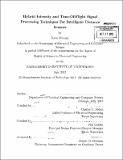| dc.contributor.advisor | Charles G. Sodini and Phil Golden. | en_US |
| dc.contributor.author | Hiromi, Itaru | en_US |
| dc.contributor.other | Massachusetts Institute of Technology. Department of Electrical Engineering and Computer Science. | en_US |
| dc.date.accessioned | 2014-03-19T15:46:50Z | |
| dc.date.available | 2014-03-19T15:46:50Z | |
| dc.date.copyright | 2013 | en_US |
| dc.date.issued | 2013 | en_US |
| dc.identifier.uri | http://hdl.handle.net/1721.1/85809 | |
| dc.description | Thesis: M. Eng., Massachusetts Institute of Technology, Department of Electrical Engineering and Computer Science, 2013. | en_US |
| dc.description | Cataloged from PDF version of thesis. | en_US |
| dc.description | Includes bibliographical references (page 155). | en_US |
| dc.description.abstract | With the advent of "smart" consumer electronics, distance sensing is an increasingly important field in optical sensing. A novel approach to active infrared(IR) 1D distance sensing is proposed, employing both intensity and time-of-flight information. Conventional intensity based sensors lack in distance accuracy, and conventional time-of- flight sensors suffer from crosstalk and backscatter issues. The purpose of this work is to explore the solution space to these issues that hybrid intensity/time-of-flight systems enable, and to investigate their characteristics. Optical behavior of time-of-flight and intensity of an active IR system is analyzed, and a comprehensive reflection model is created. This model is then applied to describe discrete objects, and a parameterized object model is developed. Techniques such as the use of differentiated signals, least square estimation, and optimization algorithms are introduced and applied to the object model. A range of techniques based on specific use cases are developed, and their capabilities and limitations are discussed. Results show that in a limited set of conditions, combining time-of-flight and intensity information can allow the extraction of distance in conditions that are typically unfavorable for conventional methods, such as high crosstalk or high backscatter environments. Used in the right conditions, these techniques can gain immunity to these sources of error, at the cost of higher computational complexity. | en_US |
| dc.description.statementofresponsibility | by Itaru Hiromi. | en_US |
| dc.format.extent | 155 pages | en_US |
| dc.language.iso | eng | en_US |
| dc.publisher | Massachusetts Institute of Technology | en_US |
| dc.rights | M.I.T. theses are protected by copyright. They may be viewed from this source for any purpose, but reproduction or distribution in any format is prohibited without written permission. See provided URL for inquiries about permission. | en_US |
| dc.rights.uri | http://dspace.mit.edu/handle/1721.1/7582 | en_US |
| dc.subject | Electrical Engineering and Computer Science. | en_US |
| dc.title | Hybrid intensity and time-of-flight signal processing techniques for intelligent distance sensors | en_US |
| dc.type | Thesis | en_US |
| dc.description.degree | M. Eng. | en_US |
| dc.contributor.department | Massachusetts Institute of Technology. Department of Electrical Engineering and Computer Science | |
| dc.identifier.oclc | 872118625 | en_US |
